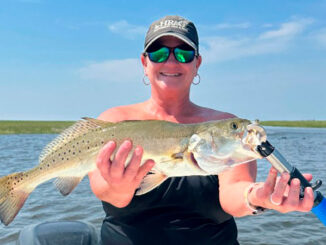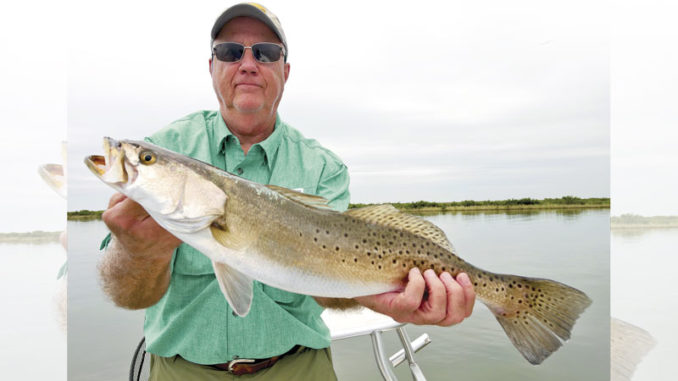
Water salinity drives Louisiana’s speckled trout to different areas at different times of year, for different reasons. Understanding the process can put you around a lot more fish this month.
Two things push speckled trout anglers around in the Mississippi River estuary: turbidity and salinity. Turbidity is the visible one — and most anglers know not to mess with high turbidity — but many don’t realize that the invisible property of water salinity is also pushing them around in their search for fish.
In water-quality jargon, salinity is the measure of dissolved salts in water, but for inshore anglers it is a measure of the estuary’s life blood. It’s the salinity gradient of an estuary that creates the most ecologically rich marine habitat on earth and the incredible fishing opportunities. It is aptly called the nursery of the sea, and most fish and shellfish eaten in the United States complete at least part of their life cycles in estuaries.
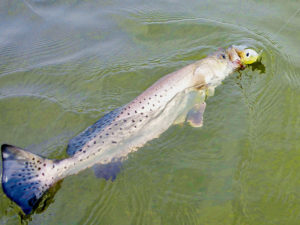
Understanding salinity
For anglers, the best mental map of an estuary is not a splattering of fishing spots on your grandfather’s map, but instead, fishing spots overlaid on the most up-to-date salinity map. A map of the salinity gradient tells us where the trout will not be, which is halfway to knowing where they are. That may sound as helpful as a bicycle with one pedal, but finding trout in the massive Mississippi River estuary is about narrowing the odds.
The salinity gradient starts where freshwater and saltwater first mix — for example, the mouth of Bayou Lacombe or Grand Lake near Delacroix Island — and it ends where full saltwater persists: the Gulf of Mexico. Scientists break an estuary into three zones based on salinity: intermediate marsh zone (which has salinity in the 3 to 10 parts per thousand range), brackish zone (10 to 20 ppt), and saline zone (more than 20 ppt).
Trout use the whole of the salinity gradient. They use the saline zone for spawning and for feeding on plentiful summer food. They use the intermediate marsh zone for protection in winter from storms and large predators. Lastly, they use the salinity gradient to follow food such as shrimp, which grow in low-salinity water but travel to high salinity as they mature. Speckled trout can survive across the entire salinity gradient because they are euryhaline organisms.
The amazing euryhaline fish
A euryhaline organism has the biological capacity to adjust to variations in water salinity. The drum family is one of the most-prolific euryhaline fish in the southern waters. These include Atlantic croaker, black drum, red drum (redfish), and seatrout, including the beloved spotted seatrout (specks).
Animals and fish use electrolytes to balance blood properties, rebuild damaged tissue and hydrate their bodies. Electrolyte strength is created by dissolved salts in the bloodstream, and because the pressure of the water around a fish causes it to adsorb water constantly, keeping a healthy electrolyte level is a constant chore for a fish. Too much or too little dissolved salt in its bloodstream spells death for a fish, and fish species suited to a tight salinity range cannot live outside of that range.
A freshwater fish does not drink water, or not regularly, because it adsorbs plenty of water through membranes. Salt is precious to a freshwater fish because of its constant adsorption of low-salt, freshwater can dilute its electrolytes to dangerously low levels. To compensate, these fish get rid of much water through urination and use a biological system to strip salt out of their urine, which can then be used to maintain a healthy electrolyte level in the blood stream. Tragically, if they become stuck in high-salinity water, their bodies can not get rid of the salt, and their electrolyte levels go too high and they will die.
Saltwater fish
Saltwater fish are just the opposite. They are in danger of adsorbing too much salt and not enough water, thus becoming dehydrated. To keep their electrolytes balanced, they drink large volumes of saltwater and rid their bodies of much salt by discharging a briny urine. Sadly, if they get trapped in low-salinity water, they will keep chugging the water, dilute their blood stream, drop their electrolyte levels, and die.
Now we can understand how amazing a euryhaline fish is, that it can balance its electrolyte levels when living for months at a time in 3 ppt water or 35 ppt water.
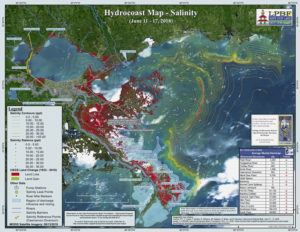
Salinity and reproduction
In Louisiana, early spawners start around the middle of May, and the spawn can continue into September. Trout do not spawn in beds like a bass; instead, they are broadcast breeders. Male speckled trout school and use their swim bladders to create that iconic drumming sound, which draws in females. Females lay their eggs at the same time the males emit sperm. The eggs and sperm must suspend in the water column to give the eggs time to become fertilized, and then the eggs need to remain suspended until they reach the larval phase. If they fall to the bottom, they are likely to die. During this critical period, salinity shows it is worth its salt.
Less-dense objects float in saltwater, and a drop of oil inside each trout egg makes it lighter than the water it’s in, which is approximately 17 parts per thousand in spawning areas.
Somehow, a female speckled trout is able to gauge water salinity and spawn in water where her eggs can float. This is not really surprising, because the fish’s euryhaline biology is constantly adjusting salt retention to maintain a healthy electrolyte level.
The mental map
With the connection established between the salinity gradient and the locations where trout will be found in June, anglers need to look where the water has roughly 17 ppt or higher salinity; that will eliminate a significant area of the estuary. But how do we know where the 17 ppt threshold is on the day we want to fish?
Look in three places.
First, the U.S. Geological Survey (USGS) has several online water-quality gauges spread along the coast, including: Crooked Bayou (#073745257) near Delacroix, the Mississippi Sound near Grand Pass (#300722089150100), Rigolets at Hwy 90 near Slidell (#301001089442600), Empire Waterway south of Empire (#07380260), and Black Bay near Stone Island (#073745275). There are other useful gauges spread along the coast, and they are found on the at USGS Current Water Data for the Nation website at, https://waterdata.usgs.gov/nwis/rt.
Second, the Lake Pontchartrain Basin Foundation (LPBF) provides hydrocoast salinity maps. The maps forecast salinity and water movement for the Lake Pontchartrain Basin and the Barataria Basin; they are an incredible resource for researchers, government officials, and anglers. They are free and can be found at https://saveourlake.org/lpbf-programs/coastal/hydrocoast-maps/.
Third, we can salinity when on the water to get local readings, especially in the 17 ppt threshold areas.
Hydrometer
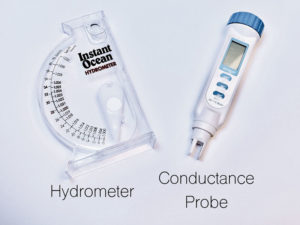
I have caught trout during the spawning season on structure that was close to the threshold, but having salinity around 10 to 15 ppt. I believe they were not spawning but were likely in the period of egg-sack development. At that time, they have freedom to travel up the salinity gradient where advantages in food or protection may exist. Knowing if a productive spot is near the salinity threshold on any particular day becomes helpful.
The least-expensive instrument to measure salinity is the hydrometer, which can be bought from businesses that sell aquarium supplies for about $15. I use a more-accurate device called a conductance probe, which costs about $75. The conductance readings from these instruments are easily converted to salinity values.
Baits for early summer
Biologists believe that speckled trout show a preference for shrimp in their diet during the spawning season; this may be related to the nutritional requirements for egg development. Shrimp are lower in fat than many finfish species but higher in protein and essential minerals. Shrimp are also plentiful in the brackish and saline zones during the summer, so convenience may also be a factor in the diet preferences of speckled trout.
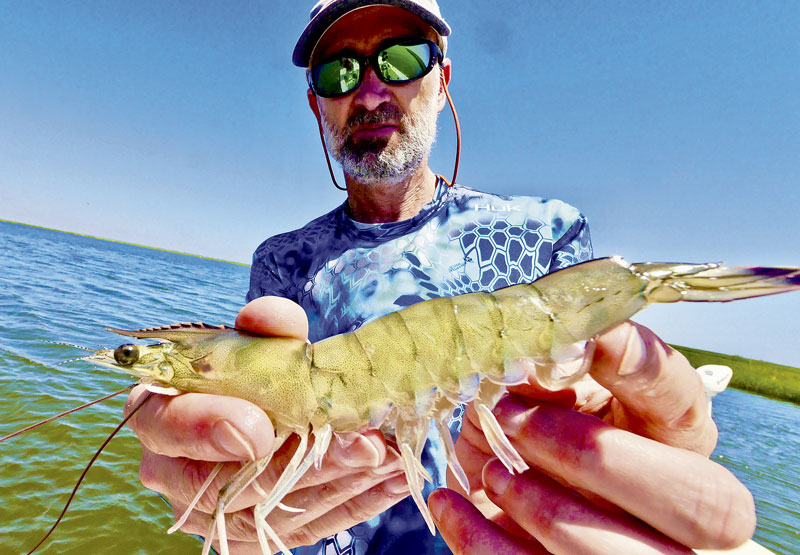
Whatever the reason, fishing with live or artificial shrimp is a productive method in early summer, and the popping cork adds an additional advantage to either of these two types of bait. In early summer, topwater stickbaits produce big blowups and big trout when thrown over shallow flats in the morning. Shallow-running, lipped jerkbaits are also in many anglers’ arsenals for June, but they need to be worked them harder than earlier in the year.
